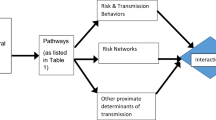Abstract
The public health community and general public collectively face a crisis of major proportions. Diseases such as HIV-AIDS, sexually transmitted diseases, cancer, strokes, coronary artery disease and others have grown in morbidity and mortality and render high-risk populations at the greatest vulnerability in history. In the case of AIDS, while the death rate is decreasing due to more effective medications such as protease inhibitors and azidothymidine, those infected are still victims of eventual death. The reality of the vast morbidity and mortality that we face precipitates a greater search for prevention. We now know and understand that HIV-AIDS, sexually transmitted diseases, drug abuse, alcohol abuse, and most other urban health problems are preventable.
Access this chapter
Tax calculation will be finalised at checkout
Purchases are for personal use only
Preview
Unable to display preview. Download preview PDF.
Similar content being viewed by others
References
Bandura, A. (1977). Self-efficacy: Toward a unifying theory of behavior change. Psychological Review, 84, 191–215.
Bandura, A. (1977). Social learning theory. Englewood Cliffs: NJ: Prentice-Hall.
Baltimore City Health Department. HIV Surveillance Project. March 2000.
Bradley-Springer, L. (1996). Patient education for behavior change: Help from the transtheoretical and harm reduction models. Journal of the Association of Nurses in HIV-AIDS Care.
Chissel, John (1999). The health behavior change symposium sponsored by Morgan State University, June 1999. Funded by Kellogg Foundation, Baltimore, Maryland.
Chissel, John (1993). Pyramids of power: An ancient African centered approach to optimal health. Baltimore, MD: Positive Perception Publication.
Center for Disease Control and Prevention (1997). Youth risk behavioral survey, National school based with 150schools. Atlanta, 6A: CDC.
Center for Disease Control and Prevention (1998). National school based youth risk behavioral survey. Atlanta, 6A: CDC.
Chunn, J.C., Dunston, P.J., and Ross-Sheriff, F. (1983). Mental health and people of color: Curriculum develop ment and change. Washington, D.C.: Howard University Press.
Fishbein, M. (1967). Attitude and the prediction of behavior: Results of a survey sample. In M. Fishbein (Ed), Readings in attitude theory and measurement. New York: Wiley.
Fishbein, M. and Ajzen, I. (1975). Beliefs, attitudes, intention and behavior: Introduction to theory and researchreading. Reading: MA: Addison-Wesley.
Grimley, D., Riley, G., and Balin, J. (1993). Assessing the stages of change and decision making for contraception: Use, prevention of pregnancy, sexually transmitted. Health Education Quarterly. 20.
Kalichmen S. Carey, M., and Johnson, B. (1996). Prevention of sexually transmitted HIV infection: A meta- analytic review of the behavioral outcome literature. Analysis of Behavior Medicine. 18, 6-D.
Lau, R. (1982). Origins of health locus of control beliefs. Journal of Personality and Social Psychology. 42, 322–334.
Osborne, O., Carter, C, Pinkieton, N., and Richards, H. (1987). Chapter 13: Development of African American curriculum content in psychiatric and mental health nursing. In J.C. Chunn, J.P. Dunston, Ross-Sheriffs Mental health and people of color: Curriculum development and change. Washington, D.C.: Howard University Press, (1983).
Prochaska, J. and DiClemente, C. (1983). Stages and process of self-change of smoking: Toward an Integrative Model of Change. Journal of Consulting and Clinical Psychology. 5, 390–395.
Prochaska, J. and DiClemente, C. (1984). The transtheoretical approach: Closing the traditional boundaries oftherapy. Homewood, IL: Dow-Jones/Irvin.
Prochaska, J., Reading, C, Harlow, C., Rossi, J., and Veficer, W. (1994). The trans-theoretical model of change and HIV prevention: A review. Health Education Quarterly. 21, 471–486.
Prochaska, J., Reading, C., Harlow, C., Rossi, J., and Veficer, W. (1994). The trans-theoretical model of changeand HIV prevention.
Kaiser Family Foundation (1998). National survey of African Americans and HIV-AIDS. March.
Rosensock, I. (1990). The health belief model: Exploring health behavior through expectance. In Glanz, Lewis Reimero (Eds), Health behavior and health education: Theory, research and practice. San Francisco: Josey Bass.
Satcher, D. (2000). Eliminating disparities in health: The surgeon general s prescription. Speech delivered at Morgan State University on February 3, 2000, in celebration of the first year of the Doctor of Public Health Degree Program by Dr. David Satcher, Surgeon General of the United States and Assistant Secretary of Health, Department of Health and Human Services. Baltimore, Maryland.
Wallston, K. and Walliston, B. (1982). Who is responsible for your health?: The construct of health locus of control. In G. Sanders and J. Suls (Eds), Social psychology of health and illness. Hillsdale, NJ: Lawrence Erlbaum.
Editor information
Editors and Affiliations
Rights and permissions
Copyright information
© 2002 Springer Science+Business Media New York
About this chapter
Cite this chapter
Chunn, J.C. (2002). The Health Behavioral Change Imperative. In: Chunn, J.C. (eds) The Health Behavioral Change Imperative. Springer, Boston, MA. https://doi.org/10.1007/978-1-4615-0731-4_1
Download citation
DOI: https://doi.org/10.1007/978-1-4615-0731-4_1
Publisher Name: Springer, Boston, MA
Print ISBN: 978-1-4613-5214-3
Online ISBN: 978-1-4615-0731-4
eBook Packages: Springer Book Archive



